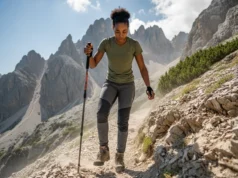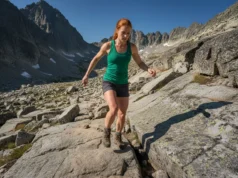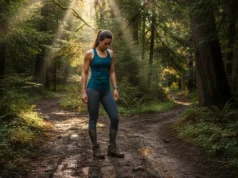In this article
Imagine this: you’ve reached the summit of the superior hiking trail, the view is breathtaking, but all you can think about is the searing pain in your feet. The wrong hiking boot doesn’t just cause discomfort; it can end a trip and ruin your love for the trail. Choosing the right boot is the single most important gear decision a hiker can make. This guide isn’t just a review listicle; it’s a complete buyer’s guide designed to match you with the perfect pair of female hiking boots, ensuring every step is one of confidence and comfort, not compromise.
- Learn the Language: We’ll break down the six critical performance factors—from Support to Weather Resistance—that define a great boot, so you can evaluate any hiking boot options like a pro.
- Find Your Hiker Type: Discover whether you’re a Dedicated Day Hiker, a Serious Backpacker, or a Fast-and-Light Specialist. Your hiking philosophy dictates your ideal boot.
- Trust the Testing: See our top lab tested and trail-proven recommendations for 2025, curated for each hiker type, ensuring there’s a perfect match for your specific needs, whether you need mountain boots womens or trail boots womens.
- Make a Confident Choice: Move beyond brand hype and use our metric-driven analysis to invest in footwear that protects your feet, supports your goals, and enhances your time outdoor.
How to Choose the Right Female Hiking Boots: An Expert’s Framework
Let’s cut through the marketing noise with a proper how to choose guide. To make a smart, confident choice, you need to speak the language of gear. We’re going to turn those confusing technical specs into clear, actionable decision criteria. This is the framework I use to evaluate every piece of women-specific hiking footwear that comes through my program, and it will empower you to do the same.
Why are Comfort and Fit the Most Critical Factors?
Of all the metrics we test, nothing matters more than understanding how hiking boots should fit. A boot can have world-class excellent traction and be bombproof, but if it doesn’t fit your foot, it’s worthless. Comfort, however, is a two-part concept. There’s the initial comfort you feel in the store, which often feels sneaker-like and requires no break-in period. Then there’s structural comfort, which comes from a firmer, more supportive boot that prevents foot pain over long, hard miles. A softer shoe feels great on a one-mile walk but can leave your feet aching after ten trail miles with a heavy pack.
The architecture of that comfort begins with the toe-box volume and footwear width. Your feet naturally splay, or spread out, under load. A wide, anatomical toe box, especially important for those with wide feet, allows for this, which is absolutely critical for preventing pain and bruised toenails on long descents. Next, you need a secure heel lock. If your heel is lifting and sliding with every step, you’re just creating friction. That friction turns into a hotspot, and that hotspot becomes a trail-ending blister. A well-designed boot cups your heel and holds it firmly in place. Finally, consider the break-in period and the break-in timeline. Modern synthetic boots offer the immediate gratification of a near-perfect fit out of the box. Stiffer, more durable leather boots, however, require an investment of time. Breaking them in is a necessary process of molding that tough material to the unique shape of your foot, but the payoff is a custom fit that can last for a decade.
Pro-Tip: Always try on new hiking boots at the end of the day, when your feet are most swollen. Wear the exact same type of socks you plan to hike in to get the most accurate assessment of fit and foot volume.
While comfort prevents pain, the boot’s underlying structure is what prevents injury. It’s a truth backed by hard data from institutions like the National Center for Biotechnology Information, which has studied the biomechanics of foot blister prevention in hikers. A great fit is the first and most important part of a comprehensive system for preventing blisters.
How Much Support and Stability Do You Really Need?
This is where you match your boot to your mission, whether it’s day hikes or multi-day backpacking trips. Support is a boot’s ability to protect the foot and ankle from the immense stress of carrying a load—especially an ideal load greater than 35 lbs—across uneven ground. This is the single biggest reason to choose a full hiking boot over a trail shoe. The key here is torsional rigidity (sometimes referred to as the stiffness rating), which is a boot’s resistance to twisting. Think of wringing out a wet towel; a good boot resists that motion. This stability comes from a “shank,” a stiff piece of material (often nylon or TPU) embedded in the midsole, which provides crucial arch support.
A high, padded ankle collar is another critical component of ankle support. It physically braces your ankle, helping to prevent painful rolls, whether it’s an inversion (rolling outward) or eversion (rolling inward). This isn’t just about comfort; it’s about preventing the kind of injury that requires a rescue, a fact reinforced by biomechanical studies from the U.S. Army Research Laboratory on how boot design impacts stability. But here’s the fundamental trade-off you must always consider: more support and stability almost always mean more weight and less agility. This is the core conflict you have to resolve when deciding between trail runners and hiking shoes. Heavy boots are a lifesaver in the scree fields of the high alpine, but are often overbuilt for day hikes on a well-worn trail.
A stable boot is useless if it can’t grip the ground, which is where the outsole comes in.
What Makes an Outsole “Grippy” and Durable?
Traction isn’t magic; it’s engineering. It comes down to two primary factors: the rubber compound, which determines stickiness, and the lug design—its lug depth, pattern, and spacing. Deep, widely-spaced, and aggressive lugs are designed to bite into soft terrain like mud or loose dirt and then shed it, so you don’t get caked-up. Stickier rubber compounds, on the other hand, are what you want for smearing on solid rock. For steep descents, look for a feature called a “heel brake”—or deep braking lugs—which is a distinct, sharp-edged rear lug pattern that helps you dig in and control your speed.
Leading brands like Vibram, with its famous Megagrip compound, and Salomon, with its Contagrip technology, have built their reputations on this science. But once again, there’s a trade-off. The stickiest rubber compounds provide excellent traction but tend to wear out faster. Harder, more durable rubber will last for more miles but offers less grip, especially on wet surfaces. Even the best grip won’t help if the boot itself falls apart, and it’s important to know when winter conditions demand specialized traction devices that go beyond what any outsole can provide.
Do You Need a Waterproof Boot? (The “Waterproof Paradox”)
This question trips up more hikers than any other. Weather resistance is a two-part system: it’s about keeping external water from getting in (waterproofing) and letting internal water vapor from your sweat get out (breathability). This leads us to the “Waterproof Paradox.” The very same waterproof membrane, like a GORE-TEX liner, that brilliantly blocks water droplets from a stream crossing also inherently restricts the breathability of the boot. In hot, dry conditions like a desert canyon, this can be a huge liability, leading to sweat-soaked feet (feet sweat) that are just as prone to blisters as feet soaked by rain.
Pro-Tip: To maintain your boot’s performance, regularly clean the uppers and re-apply a DWR treatment like Nikwax. Proper boot cleaning and care restores the boot’s breathability and prevents the outer fabric from “wetting out,” which makes the waterproof membrane work much more effectively.
Your choice should be entirely climate-dependent. For the Pacific Northwest or New England, a waterproof boot is a wise investment. For summer in Utah or Arizona, a non-waterproof, highly breathable and hot-weather vented boot is often the superior choice because it will dry out much faster after getting wet. The first line of defense is always a Durable Water Repellent (DWR) finish on the boot’s outer upper material, which causes water to bead up and roll off. When that wears out, the waterproof membrane becomes your last resort. It’s crucial to understand these nuances as you explore the pros and cons of waterproof hiking shoes.
Now that you can decode a boot’s performance, let’s pull back the curtain on how we test.
Our Selection Process: How We Built This Guide
Trust is earned on the trail, and we believe it should be earned in our gear guides, too. This isn’t a random list of popular boots. Our recommendations are the result of a comprehensive process designed to give you total confidence in your choice.
First, we committed to objectivity. We don’t just repeat marketing claims; we analyze performance. This guide is a synthesis of data from expert lab tests that measure things like water-resistance and sole stiffness, long-term field reports from seasoned thru-hikers with thru-hike credentials, and a deep analysis of thousands of real-world user reviews to identify patterns in durability and fit. We even include mileage disclosure where possible.
Second, we used a consistent evaluation framework. Every single boot considered for this guide was judged against the same six uncompromising performance criteria: Comfort, Support & Stability, Traction, Durability, Weather Resistance, and Weight. This allows for true, side-by-side comparison.
Third, we curated our selections for you. We know that the “best” boot for a weekend warrior is not the best boot for a backpacker carrying 50 pounds. So, our process was two-fold. We started by identifying three core “Hiker Personas” that represent the distinct needs of our community, from day hikes to backpacking and scrambling. Then, we meticulously matched the top-performing boots from our analysis to the persona they serve best, ensuring every recommendation is targeted, relevant, and solves a specific problem.
Finally, a note on how we keep the lights on. If you purchase a boot through our links, we may earn a small commission at no extra cost to you. This helps fund our independent research and allows us to keep buying gear for testing instead of relying on manufacturer handouts. We only recommend gear we genuinely believe in. Our credibility is our most important asset, and we would never trade it for a quick buck.
The Best Female Hiking Boots of 2025: Our Top Recommendations for Every Need
Now it’s time to meet your match. We’ve done the legwork, parsed the data, and hit the trail. Below are our top-performing boots, organized by the type of hiker they serve best. Find your persona, and you’ll find your perfect pair of womens mid hiking boots.
Our Top Picks for “The Dedicated Day Hiker”
Our Top Picks for “The Serious Backpacker”
Our Top Picks for “The Fast-and-Light Specialist”
Conclusion
The search for the perfect hiking boot is a journey of understanding trade-offs. The most supportive boots are rarely the lightest, and the most comfortable pairs right out of the box may not be the most durable for a cross-country trek. The fastest way to narrow your choices and find a boot that truly serves your goals is to first understand your primary hiking style—whether you’re a Dedicated Day Hiker, a Serious Backpacker, or a Fast-and-Light Specialist. Remember that a waterproof membrane is a fantastic tool for wet, cool climates, but it will always come at the cost of breathability, often making non-waterproof boots a smarter choice for hot, dry environments. Ultimately, a proper fit, with a locked-in heel and ample room for your toes, is more critical than any brand name or feature for preventing trail-ending pain and blisters.
You’re now equipped with the expert knowledge to make a confident choice. Revisit the recommendations for your Hiker Persona, invest in your trail comfort, and step into your next adventure with the right foundation on your feet.
Frequently Asked Questions about Female Hiking Boots
How long should a good pair of hiking boots last?
A quality pair of hiking boots should last between 500 and 1,000 miles. This range depends heavily on factors like the terrain use-case, your body weight plus pack weight, and the boot’s construction. Boots built with full-grain or nubuck leather uppers and dense Polyurethane (PU) midsoles, like the Lowa Renegade GTX Mid or Oboz Bridger Mid WP, generally offer the longest lifespan as these materials are more resistant to abrasion and compression over time compared to lighter synthetic materials like mesh and EVA foam.
Is it worth paying more for GORE-TEX waterproofing?
It depends entirely on your primary hiking environment. For hiking in consistently wet, muddy, or cold conditions, the answer is a definitive yes. GORE-TEX remains the industry benchmark for reliable, durable waterproof and breathable performance. However, if you primarily hike in hot, dry climates like the American Southwest, you’ll likely benefit more from the superior breathability of a non-waterproof boot. In that case, you can save money and increase your comfort by choosing a non-GTX model or a boot with a quality proprietary membrane, like the B-DRY system in the Oboz Sawtooth X Mid WP.
What is the most important factor: comfort or support?
The answer hinges on your pack weight. For day hikes with a light pack (under 20 pounds), you can and should prioritize out-of-the-box, plush comfort. A flexible boot like the Merrell Moab 3 WP will feel great. For backpacking with a heavy pack (over 35 pounds), you must prioritize structural support. A supportive boot like the Salomon Quest 4 GTX has a stiff sole and robust ankle support that prevents foot fatigue and potential injury under a heavy load. This provides long-term structural comfort over many miles, which is ultimately more important than initial softness.
Do I really need to break in my hiking boots?
This depends on the boot’s upper material. Modern synthetic boots, like the Salomon X Ultra 4 Mid GTX, are made from flexible textiles that conform to your foot quickly and require little to no break-in period. However, stiffer, full-leather boots, such as the Oboz Bridger Mid WP, absolutely require a dedicated break-in period. The tough leather needs time and mileage to soften and mold to the unique contours of your foot. Regardless of the material, you should always wear new boots around the house and on short walks on paved surfaces before committing to a long hike to identify any potential hotspots.
Risk Disclaimer: Hiking, trekking, backpacking, and all related outdoor activities involve inherent risks which may result in serious injury, illness, or death. The information provided on The Hiking Tribe is for educational and informational purposes only. While we strive for accuracy, information on trails, gear, techniques, and safety is not a substitute for your own best judgment and thorough preparation. Trail conditions, weather, and other environmental factors change rapidly and may differ from what is described on this site. Always check with official sources like park services for the most current alerts and conditions. Never undertake a hike beyond your abilities and always be prepared for the unexpected. By using this website, you agree that you are solely responsible for your own safety. Any reliance you place on our content is strictly at your own risk, and you assume all liability for your actions and decisions in the outdoors. The Hiking Tribe and its authors will not be held liable for any injury, damage, or loss sustained in connection with the use of the information herein.
Affiliate Disclosure: We are a participant in the Amazon Services LLC Associates Program, an affiliate advertising program designed to provide a means for us to earn advertising fees by advertising and linking to Amazon.com. As an Amazon Associate, we earn from qualifying purchases. We also participate in other affiliate programs and may receive a commission on products purchased through our links, at no extra cost to you. Additional terms are found in the terms of service.





